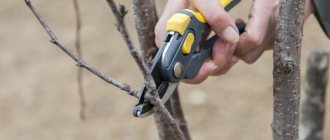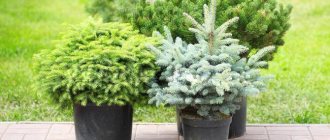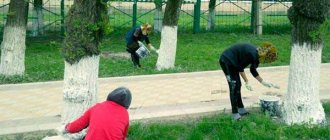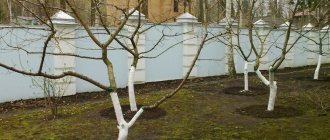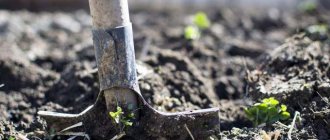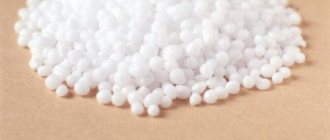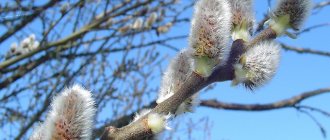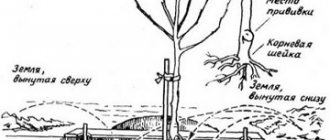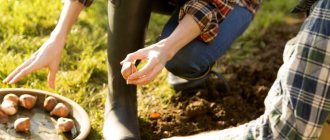Whitewashing is an effective agricultural technique for proper garden care. This is especially useful for fruit species, in particular apple trees. Modern selection focuses on fruit size, ripening speed, yield, and taste. The characteristics of acquired immunity are relegated to the background. They are many times inferior to the natural immunity of wild plants that are resistant to negative climate conditions, diseases, and agricultural pests.
Why do you need whitewashing?
Applying slaked lime to the bark creates a repellent barrier with good decorative properties. After treatment, the garden looks neat and refreshed. As the tree grows, the outer layer becomes coarser, loses its uniformity, becomes covered with cracks, peels and flakes off in places. The largest scale of surface transformations occurs in the root area of old trunks. On the one hand, they improve moisture absorption, gas exchange, elasticity, and resistance to mechanical damage. On the other hand, they violate the protective integrity of the integument at the micro level, increasing damage under negative external influences. The use of lime mortar allows you to “seal” problem areas on the trunk, achieve a reflective effect, and create a repellent taste and smell for pests.
Whitened apple trees in time acquire enhanced protection from:
- sunburn;
- cracking due to strong winds and frost;
- warping due to sudden temperature changes;
- infection with rot, fungal spores, pathogens, infections.
- penetration of insect pests;
- eating trunks by rodents and lagomorphs.
Important!
An apple tree with whitewash is an unfavorable environment for microorganisms, adult insects, larvae, and pupae due to the fungicidal and insecticidal properties of lime. After drying, the lime composition forms a dense white coating with a thermal insulating effect, which protects the bark during the leafless season from freezing, ultraviolet burns, and false provocations to sap flow. During the thaw period and bright winter sun, there is a high risk of the trunk warming up to +9-10°C. Such temperatures are typical for the spring movement of nutrients from roots to branches. Returning frosts turn the sap into ice, which, due to the increased volume, destroys the cells of the bark, phloem and cambium.
Why do you need to whiten apple trees?
In January, premature heating can lead to the movement of sap in the tree; when the temperature drops, the sap begins to crystallize, and this destroys the trunk. Whitewashing is designed to enhance the protective properties of the apple tree, prevent destruction of the tree surface, destroy pests, and protect it from the negative effects of temperature and sunlight.
Fact!
Whitened trees will live longer and bear more fruit.
Painting protects:
- Temperature changes lead to cracks in the bark.
- For sunburn, this is especially important in the fall, when the tree lacks foliage that can protect the trunk from ultraviolet radiation.
- From frost. The active movement of sap, coupled with frost, forms ice inside the tree, which kills the plant.
- Parasites, rodents, mites, flower beetles, ants, these animals damage the trunk by eating it.
Whitewashing apple trees in the fall is an annual procedure for many gardeners, because it has many advantages.
Features and timing
Comprehensive garden care involves whitewashing apple trees in spring and autumn. This approach takes into account the gradual washout of whitewash by precipitation and the life cycle of insect pests. For example, during autumn cold snaps, the codling moth climbs into cracks in the bark for wintering, and with the onset of spring warming, it lingers on the trunk to pupate.
To get the desired result, it is better to whiten apple trees based on specific deadlines. Additional prevention during winter and summer will help to further increase the efficiency of garden care. For ease of use, all information is summarized in one table.
| Season | Month | For what | Peculiarities |
| Spring | March, April | Disinfection, stimulation of trunk renewal. Fight against codling moth and flower beetle | Requires early deadlines to be met. In May it becomes ineffective and is decorative in nature. |
| Summer | June July | Renewal of the limestone layer after frequent rainfall. Prevention of rot and fungi. Increased resistance to solar radiation | Maintaining the overall health of the tree |
| Autumn | October November | Autumn whitewashing of apple trees is key for comprehensive protection of the trunk. Aimed at combating wintering insects and their larvae, winter overheating, frostbite, and cold winds | Good at preventing mice and hares from gnawing on them |
| Winter | February | Is analogous to early spring treatment | It is necessary if no winter treatment was carried out or if rainy weather with thaws washed away the lime. Needs repeating in April |
Important!
Apple trees need to be whitened in the fall 1-2 weeks before the onset of frost, so that the growing bark does not begin to destroy the protective surface before the onset of cold weather.
When to whitewash trees
in autumn
Experienced gardeners say that trees need to be whitened 2-3 times a year: at the beginning of the spring, as well as in summer and autumn. In this case, the main whitewashing is carried out in the fall. The best time to carry out this procedure is October or November, shortly before the first frost. Autumn whitewashing helps protect plants from harmful insects and pathogenic fungi that have gathered to overwinter in the bark. In addition, the whitened trunks will be protected from the formation of ice, and hungry rodents will avoid them.
in spring
If the trees have been unbleached over the winter, then whitewashing will need to be done at the end of winter or beginning of spring. It is best to do this in February. The fact is that at the end of winter, during the daytime, unbleached trunks can be heated by the scorching rays of the sun up to 11 degrees. And this can lead to the start of sap flow. However, in February at night the air temperature can still drop to minus 10 degrees, so the juice may freeze. As a result, rupture of plant tissues and the formation of frost holes, which are deep and large cracks in the bark, are often observed. If there is a white coating on the surface of the trunk and the base of the skeletal branches, then it will reflect the rays of the sun. Thanks to this, the bark will not heat up, as a result of which sap flow will not begin prematurely and frostbites will not appear. If the trees were whitewashed in the fall, it is recommended to refresh the whitewash in the spring. In this case, it is carried out in February–March or in the first days of April.
Do trees need summer whitening? If the whitewash from the trees was washed away by heavy rains, experts recommend refreshing it in the summer. But if the trunks are coated with a stable compound that is very difficult to wash off, then there is no need to bleach them in the summer. Remember that trees need to be whitened at any time of the year on a fine day, when there is no rain or snow.
At what age do apple trees begin to whitewash?
Aggressive lime can cause thermal damage to thin bark. That is why it is recommended to bleach apple trees in the fall or spring, starting at the age of 7-8 years. By this time, the smooth coating of the trunk thickens several times and forms the first depressions and cracks. In practice, whitewash is also safely applied to younger trees (1-3 years old). For this, a weak composition is used, which is 2-2.5 times inferior to the classic recipe in terms of lime concentration.
For winter protection from the cold, young fruit trees are covered with spruce branches or binding material (burlap, garden film, non-woven insulation). The metal mesh will prevent fatal damage to the thin trunk by hares. To reduce the risk of small rodents eating the bark, you should treat the soil with Bordeaux mixture.
Equipment for whitewashing trees
Of course, a necessary detail in whitewashing will be a brush. Even so, there are plenty to choose from:
- The wash brush is a universal one. Suitable for both young, smooth trees and the well-worn, wrinkled bark of old ones. Nowadays you can buy a brush of a suitable shape, either artificial or authentic - made from linden bast (bast from the lower layer of linden bark).
- Flat brush – for young trees. However, experienced summer residents have a kind of life hack - you can tie several pieces together and paint over anything with the resulting “bouquet”.
- A paint roller is a modern solution to an old problem. Increased speed, but slightly less accuracy on uneven barrels.
- Sprayer – for large gardens and busy gardeners. It is better to put on a respirator and definitely paint in two layers: one layer from the spray gun will be thin and will quickly crack.
You will also need garden pitch (wax, rosin, and oil) or clay mash (clay and mullein in a 2:1 ratio) to putty large cracks. And a solution of a suitable disinfectant - purchased or homemade, from copper sulfate with HOM or Bordeaux mixture.
Preparing an apple tree for whitewashing
Before applying the protective composition, it is necessary to carry out three preparatory stages, which will increase the effectiveness of the procedure and allow you to eliminate some of the problems now.
Barrel cleaning
Requires accuracy and thoroughness. Not only exfoliated and dead particles are removed, but also growths, lichens, blackening, peeling, and dry knots. In some areas, deep processing is allowed with complete removal of the diseased bark and subsequent application of garden varnish. To facilitate and improve the quality of the procedure, a day with humid weather is chosen. In such a situation, the softened top layer is easier to process with a gentle tool (polymer spatula, wooden spatula, nylon brush). To avoid causing extensive damage, metal devices should only be used when absolutely necessary.
Before the procedure, you should spread polyethylene or textile material around the rhizome. The cleared residues are burned to ensure the destruction of pathogens and pests removed from the tree.
Disinfection treatment
It is carried out in compliance with personal safety measures (rubber gloves, respirator). Requires dry weather and a wind-dried trunk. Provides several options for fine spraying:
- ash-soap solution, which is prepared from 300 gr. ash (liter jar), 40 gr. laundry soap, 10 liters of water;
- Bordeaux mixture (100 g of copper sulfate, 100 g of lump lime or 150 g of slaked lime);
- medex (soda ash and copper sulfate in a 1:1 ratio).
If the composition has an unsuitable density for a spray bottle, you can use a rag. Application of the product should look like wetting the surface without the formation of large drops or running streams.
Important!
To effectively whiten apple trees in the fall, you need to wait 3 days after disinfecting the trunks.
The constant use of copper sulfate, which can accumulate in wood and fruits, should be avoided.
Wound treatment
The final stage of preparation before whitewashing the apple tree. All wounds, cracks, and cleaned recesses are covered with restorative pastes such as “Garden Var”, “BlagoSad”, “RanNet”, Lac-Balsam (artificial bark). Do-it-yourself budget option - clay mash based on 300 g. loose clay, 150 gr. mullein (manure), 100 gr. fine straw. The mixture is thoroughly mixed with the gradual addition of boiled water to obtain the consistency of viscous sour cream. After treatment, a pause of 6-24 hours is taken, which is necessary for fixing the drug on the trunk.
How to prepare wood for whitewashing?
In order for the treatment of apple trees to have an effect, it is important to properly prepare them for such a procedure. It includes three mandatory steps.
- Cleaning. The trunks of apple trees are removed from old bark, which is especially generously covered with lichens. Large segments are removed with a spatula or wooden spatula. Final cleaning is carried out with a wire brush. This procedure is best done after rain or when there is high humidity. Then the bark will be easier to remove. Removed parts must be burned to prevent the spread of infections and garden pests. For convenience, you can spread an oilcloth around the tree before cleaning.
- Disinfection. This stage of preparation for whitewashing is best done in dry weather so that rain does not wash away the disinfection solution. It can be done in several ways. You can spray the apple tree with a spray bottle of copper sulfate solution, paying special attention to the damaged areas. You can also wash the barrel with a solution of ash or ash with laundry soap. The main thing is to work with gloves. To do this, dissolve 2 kg of wood ash and a bar of laundry soap in a bucket of water.
- Covering wounds. After removing the old bark, cracks, depressions, and wounds may remain on the trunk of the apple tree. They must not be left open. Such recesses should be covered with clay mortar or special garden putty. A good protective agent is a mixture of manure and clay diluted in water. Only after these three stages can you begin to whitewash the apple trees.
See also
Description and characteristics of the Ural Nalivnoye apple tree variety, frost resistance and growing characteristicsRead
Step-by-step instructions for whitewashing an apple tree
The procedure is carried out on a fine day over dried bark using a grass, garden or paint brush. For voluminous trunks, a spray gun is better suited, which will speed up the work and ensure uniform application of the composition in a layer of 2-3 mm. When painting, it is advisable to capture skeletal branches to protect the crown from critical frost cracks.
Apple trees are whitened correctly as follows:
- prepare and infuse the solution for 2-3 hours;
- wear protective equipment (hat, long sleeves, rubber gloves, respirator or multi-layer bandage);
- Stir the infused mixture well until it has a homogeneous consistency;
- carefully remove layers of turf in the root zone to a depth of 40-50 mm;
- whitewash is applied evenly around the trunk, moving from the skeletal branches down (if the tree is large, the starting mark is located at a height of 1.7-2 meters);
- carefully treat the underground part of the trunk in the area of the removed turf.
- pause for the coating to dry completely;
- repeat steps 5,6,7;
- return the soil back and trample it firmly.
The remains of the limestone composition are added to the root soil for additional treatment against pests.
Preparation for whitewashing, tools and staining stages
Full compliance with all rules and stages of the process guarantees the desired result. First of all, you need to prepare the trunk of the apple tree.
No metal knives or brushes should be used; they cause great harm to the apple tree.
Cleaning the trunk and branches
To do this, choose cloudy weather. Cleaning is done as follows:
- Moss and lichen growths, as well as areas of damaged bark, are cleaned from the branches and trunk. This is done manually, without the use of additional equipment, only gloves are required.
- Cracks and injuries are cleaned to a healthy surface.
Bark disinfection
The next step will be disinfection of the apple tree, which is best done on a dry, sunny and windless day. This procedure is necessary:
- to destroy pathogens and insects;
- disinfection of wounds.
Suitable for disinfection: “Oxychom”, “Hom”, Bordeaux mixture. Chemical preparations can be alternated with proven folk remedies, for example, with ash-soap infusion.
Closing wounds on the bark
Next, you need to repair all damage to the bark. This is done by applying special putties. These include:
- clay;
- garden var;
- store-bought pastas.
Whitewashing procedure technology
After completing the preliminary procedures, it is time for the whitewashing itself. It is carried out in several stages:
- The soil around the tree is removed, and whitewashing begins a couple of centimeters below ground level . Upon completion, it is returned to its place.
- When painting the trunk, special attention is paid to recesses and cracks.
- Skeletal branches and forks are covered with a mixture of 1/3 of the total length , and its layer should not exceed 3 mm. Otherwise, the coating will peel off.
- Branches from the common crown are not whitened.
- The minimum height for whitewashing mature trees is 1.5 m . Young apple trees are painted up to the first branches.
Whitewashing is carried out in dry weather to allow the composition to penetrate deep into the bark.
The following tools can be used for painting:
- Paint brush - its use is justified when whitewashing a garden with water-based or acrylic paints.
- A washbrush is a tool made from linden bast that perfectly holds the working solution.
- Maklovitsa is a construction brush with a comfortable handle. This tool is ideal for whitewashing old trees. The long pile captures a large amount of the whitening mixture and perfectly distributes it over the entire surface of the bark.
- Sponge sponge - this handy material is convenient for applying solutions to low trees. The pliable structure helps fill all the cracks and bends with the solution.
- Sprayer – used for painting large areas and tall trees.
Whitewash recipe
The standard recipe involves mixing 1 kg of clay and 2.5 kg of quicklime in a 10-liter bucket of water. The clay admixture acts as a liqueur and retaining base. Often replaced with wood glue. Adding 40-50 gr. PVA (2-4 spoons) will create a shiny-reflective layer to protect the bark from burns. A couple of spoons of iron or copper sulfate will enhance the harmful effects on fungi and pathogens. A few drops of Creocid Pro (Knockdown) will repel rodents.
Ready-made formulations are always available in garden stores. For example, whitewash for apple trees “Sadovnik”, “Blok”, Avgust, “Green Belt” are very popular. Acrylic and polyacrylic paints for gardens, which have a safe water-dispersion base, are increasingly in demand.
High-quality and useful ingredients
In specialized stores there is a wide range of preparations for garden whitewash. They are made on various bases and have all sorts of useful additives.
Lime
Slaked lime is one of the most popular care products among domestic gardeners. Its affordability and useful qualities are a definite plus. For better fixation on the bark, clay must be added to the solution. There is no point in bleaching apple trees with a weak solution. Such a coating will be washed away very quickly by rain and will require repeated renewal. The mixture is prepared as follows:
- 600 g of lime are quenched with 4 liters of water.
- To enhance stickiness, pour in 4 tbsp. l. PVA glue or 1 glass of milk.
- All components are kneaded until smooth, and to enhance the disinfecting effect, 2 tbsp is added. l. copper sulfate.
Water-based paint
Whitewashing with water-based emulsion gives reliable results for a long time.
It adheres well to the trunk and does an excellent job of reflecting the sun's rays. It is better to use this paint in the spring, because it does not contain additives that have a disinfecting effect. An analogue of water-based emulsion - acrylic paint - will not only serve as a reflector, but will also protect the apple tree from fungal infections and insect attacks. The downside is the significant cost. You should not use preparations containing copper too often. It tends to accumulate in the soil and inhibit the growth of seedlings.
Chalk
Chalk is an excellent alternative to lime. With its help you can achieve a perfect snow-white finish. In addition, it has softer characteristics, which allows it to be used even for painting young apple trees. The disadvantage of chalk solutions is their fragility. Treatment with such a substance must be duplicated several times throughout the season.
Clay and mullein
This natural product is held in high esteem by gardeners because it not only plays the role of a sun reflector.
The mixture is securely attached to the bark, acting as a kind of sealing lubricant for cracks and mechanical damage. Clay and mullein have excellent thermal insulation properties, but do not block the pores of the apple tree cover. To prepare the solution you will need 3 kg of clay and 10 liters of water. Mullein is introduced later. Its volume is measured by eye, mixing into the composition until the required consistency is achieved. White or yellow clay is suitable for whitewashing.
Creolin and copper sulfate
For autumn treatment of apple trees, it is better to use the following solution:
- 2 liters of water;
- 40 g of copper sulfate;
- glue in an amount of 50% of the total contents;
- creolin;
- "Knockdown".
This mixture will not only reliably protect the integument of the fruit tree in winter from scorching sun rays and burning frost, but will also protect it from attacks by various rodents.
Shiny finish
This composition turns into a shiny coating of the bark that perfectly reflects the sun's rays. Prepare it:
- from 300 g of fluff;
- 2 liters of water;
- 2 tbsp. l. PVA glue.
Specialized whitewash solutions
Repeated testing of store-bought products reveals the instability of the resulting integument and the need for multiple repeated treatments. These include:
- GreenSquare – acrylic composition;
- Robin Green – silver biomask;
- “Gardener” – lime plus copper sulfate.
Acrylic compounds are recognized by experienced gardeners as the best store-bought product.
Features of whitewashing old and young apple trees
Fruit-bearing trees over 7-8 years old can be easily processed with all available whitewash recipes with a complex of auxiliary additives. The older the trunk and the more powerful the skeletal branches, the less the possible negative impact of the solution. Young and mature trees with thin bark also require protective treatment. Winter sunburn is more critical for fragile trunks. For this, a chalk composition is used at the rate of 1 kg of chalk per 10 liters of water. Adhesive components should be limited so as not to disrupt air exchange. Experts recommend replacing a weak solution of lime or a chalk composition with garden acrylic paint for whitewashing young apple trees.
Important!
When preparing whitewash for young apple trees, 35-50% of the weight norm of lime prescribed for the classic recipe is used.
Features of whitewashing
To properly protect an apple tree, you need to whiten the trunk: cover the entire trunk and capture the skeletal shoots. It is necessary to ensure that there are no unpainted areas, especially between the splits of the bark.
When to whiten apple trees
In order for the event to bring as much benefit as possible, it must be held regularly. It is better that the trunk is protected all year round.
In autumn, whitewashing is usually carried out in mid-October, in warm regions - in early November. In the spring, repeat the procedure when it gets warmer: at the end of March or beginning of April.
Sometimes the procedure is repeated in the summer if frequent rains have washed away the protective layer.
At what age can you start?
There are no restrictions on when to start whitening apple trees. Even freshly planted seedlings can be treated to preserve them. So, mature, adult and even old wood can and should be whitewashed. Moreover, it is recommended to cover young trunks immediately after planting, especially in cold regions. This is done to protect the young bark from rodents.
Whitewashing a young apple tree.
Common Mistakes
When whitening apple trees in the fall, recommendations on the optimal consistency of a solution similar to sour cream are most often not followed. The thick composition forms a thick layer on the trunk, but quickly cracks. Too liquid - it does not linger in cracks, flows down, and is easily washed off. It is strictly forbidden to bleach apple trees during precipitation and in violation of the recommended terms. When treating a trunk with chemically aggressive lime, the specific norm must not be exceeded so as not to provoke thermal damage to the bark.
The better to whiten
Everyone has their own “favorite recipe,” but in general, three preparations can be used for whitewashing:
- Regular lime. 3 kg of lime is enough for a bucket of water. Additionally, add a little paste so that the whitewash sticks well. And for the solution to also serve as a disinfectant, add 0.5 kg of copper sulfate. For young seedlings, a less concentrated solution should be used.
- Chalk. It is diluted using a technology similar to the preparation of lime mortar.
- Water-based paint. It is harmless to mature trees and does not require additional components.
- Water-dispersion garden paint. Contains many useful additives and stays on the trunks for up to 2 years.
